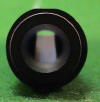email
GottaLoveTheKnowledge@gmail.com
to provide information
Click on each picture to bring up a large view. Please email
GottaLoveTheKnowledge@gmail.com to
provide additional information or pictures of clarinet mouthpieces
Read the Otto Link mouthpiece Reviews here, posts #4:
The Woodwind Forum
The Stowell Wells Schneider mouthpieces came in three facing lengths of A
(shortest), B C (longest) and three tip openings per facing length of 1, 2, 3.
Therefore A3 is a short facing, large tip opening and C1 is a long facing, short
tip opening.
B3 (tip 1.25mm)
Keyhole design – This mouthpiece is interesting. As the air/sound
travels through the mouthpiece the sidewalls move in to each other. This design,
in short, allows the player greater dynamics and the mouthpiece is generally
louder in comparison to other mouthpieces. So the player has to learn
greater playing dynamics to maintain pianissimos. Another similar end
result design on O’Briens has a “tone booster” on the baffle near the tip – this
idea (apparently) has spawned those “tone boosters” that you buy and can stick
into your mouthpiece
Read the Otto Link mouthpiece Reviews here, posts #4:
The Woodwind Forum
The Stowell Wells Schneider mouthpieces came in three facing lengths of A
(shortest), B C (longest) and three tip openings per facing length of 1, 2, 3.
Therefore A3 is a short facing, large tip opening and C1 is a long facing, short
tip opening.
B3 (tip 1.25mm)
Keyhole design – This mouthpiece is interesting. As the air/sound
travels through the mouthpiece the sidewalls move in to each other. This design,
in short, allows the player greater dynamics and the mouthpiece is generally
louder in comparison to other mouthpieces. So the player has to learn
greater playing dynamics to maintain pianissimos. Another similar end
result design on O’Briens has a “tone booster” on the baffle near the tip – this
idea (apparently) has spawned those “tone boosters” that you buy and can stick
into your mouthpiece
Stowell Wells Schneider
Read the Otto Link mouthpiece Reviews here, posts #4:
The Woodwind Forum
The Stowell Wells Schneider mouthpieces came in three facing lengths of A
(shortest), B C (longest) and three tip openings per facing length of 1, 2, 3.
Therefore A3 is a short facing, large tip opening and C1 is a long facing, short
tip opening.
B3 (tip 1.25mm)
Keyhole design – This mouthpiece is interesting. As the air/sound
travels through the mouthpiece the sidewalls move in to each other. This design,
in short, allows the player greater dynamics and the mouthpiece is generally
louder in comparison to other mouthpieces. So the player has to learn
greater playing dynamics to maintain pianissimos. Another similar end
result design on O’Briens has a “tone booster” on the baffle near the tip – this
idea (apparently) has spawned those “tone boosters” that you buy and can stick
into your mouthpiece



